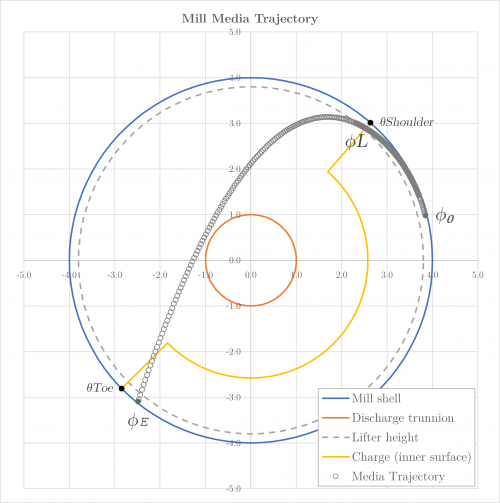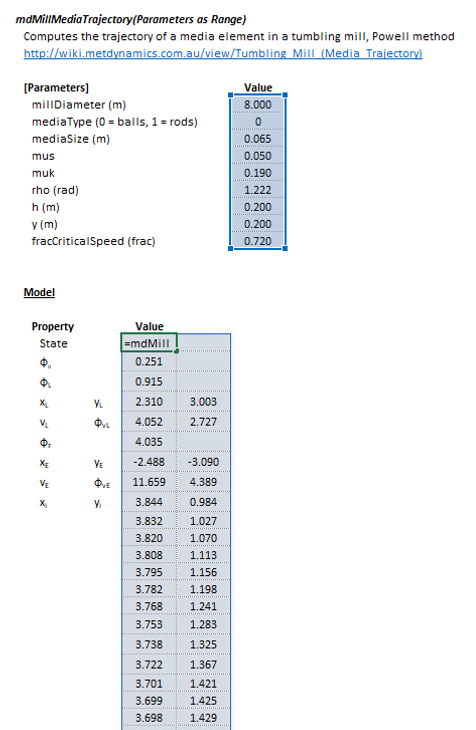Description
This article describes Powell's (1991) method for predicting the trajectory of the outer media elements in a tumbling mill.[1]
The approach predicts the point of impact of media elements projected into free flight after transit down a lifter bar surface, based on element size, lifter bar geometry, mill diameter and mill rotational speed.
The tumbling mill media trajectory model is particularly useful when combined with an estimate of charge position (e.g. Morrell's method), which allows analyses such as:
- Identifying and mitigating the risks of shell liner damage from media impact through lifter bar (or mill) design
- Monitoring trajectory and point of impact changes with charge level, mill speed or liner and lifter bar wear in operational mills
- Limiting the maximum operating speed (and hence power and throughput) in a mill simulation or process control sub-systems
Model theory
 This content is available to registered users. Please log in to view. This content is available to registered users. Please log in to view.
|
Point of equilibrium
Lifter bar tip position
Rolling
Pure rolling
Maximum angle for pure rolling
Transition to rolling and sliding
Sliding
Sliding after rolling
Pure sliding
Free-flight
Additional notes
Friction estimates
Excel
The tumbling mill media trajectory model may be invoked from the Excel formula bar with the following function call:
=mdMillPower_MillMediaTrajectory(Parameters as Range)
Invoking the function with no arguments will print Help text associated with the model, including a link to this page.
The Parameters array and model results are defined below in matrix notation, along with an example image showing the selection of the same arrays in the Excel interface:
SysCAD
The media trajectory model is an optional calculation for tumbling mill units. If selected, the input and display parameters below are shown.
| Tag (Long/Short)
|
Input / Display
|
Description/Calculated Variables/Options
|
| MediaTraj
|
| HelpLink
|

|
Opens a link to this page using the system default web browser. Note: Internet access is required.
|
| Requirements
|
| MillDiameter
|
Input/Display
|
Diameter of the mill (inside liners).
|
| FracCS
|
Input/Display
|
Fraction critical speed of the mill.
|
| MediaType
|
Ball/Rod
|
Type of media element, balls or rods.
|
| MediaSize
|
Display
|
Diameter of the media element.
|
| mus
|
Input
|
Coefficient of static friction.
|
| muk
|
Input
|
Coefficient of kinematic friction.
|
| rho
|
Input
|
Lifter face angle, angle between the face surface and the base of the lifter bar.
|
| h
|
Input
|
Height of the lifter bar.
|
| 2y
|
Input
|
Width of the lifter bar.
|
| Results
|
| PointOfEquilibrium
|
| PositionAngle / Phi
|
Display
|
Angular position of the point of equilibrium.
|
| LeavesLifter
|
| PositionAngle / Phi
|
Display
|
Angular position of the point where the media element leaves the lifter.
|
| X
|
Display
|
Cartesian x coordinate of the point where the media element leaves the lifter.
|
| Y
|
Display
|
Cartesian y coordinate of the point where the media element leaves the lifter.
|
| Velocity / V
|
Display
|
Velocity of the media element at the point where it leaves the lifter.
|
| VelocityAngle / PhiV
|
Display
|
Angular direction of the velocity of the media element at the point where it leaves the lifter.
|
| ImpactsShell
|
| PositionAngle / Phi
|
Display
|
Angular position of the point where the media element impacts the mill shell.
|
| X
|
Display
|
Cartesian x coordinate of the point where the media element impacts the mill shell.
|
| Y
|
Display
|
Cartesian y coordinate of the point where the media element impacts the mill shell.
|
| Velocity / V
|
Display
|
Velocity of the media element at the point where it impacts the mill shell.
|
| VelocityAngle / PhiV
|
Display
|
Angular direction of the velocity of the media element at the point where it impacts the mill shell.
|
| State
|
Display
|
Text description of the motion of the media element. Possible values are:
- "Element is projected into free flight from point of equilibrium."
- "Element slides to end of the lifter and is then projected into free flight."
- "Element slides and is projected into free flight before the end of the lifter."
- "Element rolls to the end of the lifter and is projected into free flight."
- "Element rolls then slides to the end of the lifter before being projected into free flight."
- "Element rolls then slides and is projected into free flight before the end of the lifter."
- "Element rolls and is projected into free flight before the end of the lifter."
|
| Trajectory
|
| ShowTrajectory
|
CheckBox
|
If enabled, the (x, y) coordinate data of the element trajectory is displayed below.
|
| TrajectoryData
|

|
Copies the full set of trajectory coordinates to the Windows clipboard in CSV format.
|
| Point, X, Y
|
Display
|
X and Y coordinates of the media element trajectory, from the point of equilibrium to point of impact with the mill shell. Only visible if ShowTrajectory is enabled above.
|
See also
References
- ↑ Powell, M.S., 1991. The effect of liner design on the motion of the outer grinding elements in a rotary mill. International Journal of Mineral Processing, 31(3-4), pp.163-193.










